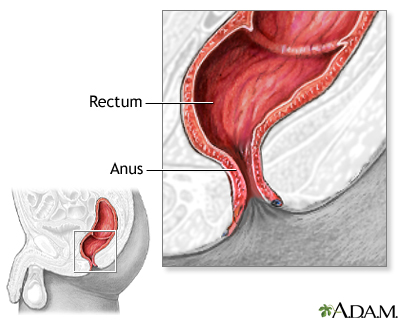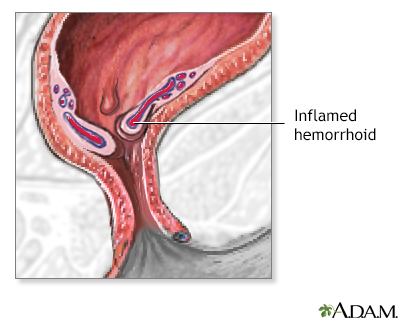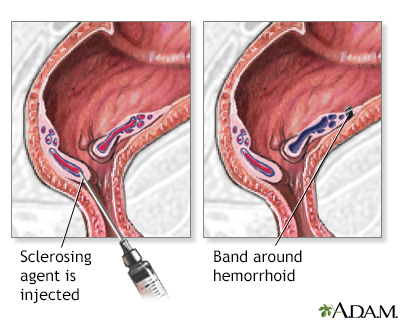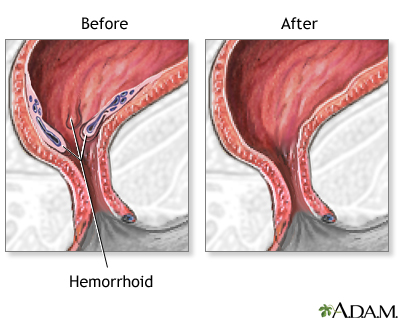Hemorrhoids
Rectal lump; Piles; Lump in the rectum; Rectal bleeding - hemorrhoids; Blood in the stool - hemorrhoidsHemorrhoids are swollen veins in the anus or lower part of the rectum.
Causes
Hemorrhoids are very common. They result from increased pressure on the anus. This can occur during pregnancy or childbirth, and due to constipation. The pressure causes the normal anal veins and tissue to swell. This tissue can bleed, often during bowel movements.
Hemorrhoids may be caused by:
- Straining during bowel movements
- Constipation
- Sitting for long periods of time, especially on the toilet
- Certain diseases, such as cirrhosis
Cirrhosis
Cirrhosis is scarring of the liver and poor liver function. It is the last stage of chronic liver disease.
 ImageRead Article Now Book Mark Article
ImageRead Article Now Book Mark Article
Hemorrhoids may be inside or outside the body.
- Internal hemorrhoids occur just inside the anus, at the beginning of the rectum. When they are large, they may fall outside (prolapse). The most common problem with internal hemorrhoids is bleeding during bowel movements.
- External hemorrhoids occur outside the anus. They can result in difficulty cleaning the area after a bowel movement. If a blood clot forms in an external hemorrhoid, it can be very painful (thrombosed external hemorrhoid).
Symptoms
Hemorrhoids are most often not painful, but if a blood clot forms, they can be very painful.
Common symptoms include:
- Painless bright red blood from the rectum
- Anal itching
- Anal ache or pain, especially while sitting
- Pain during bowel movements
- One or more hard or tender lumps near the anus
Exams and Tests
Most of the time, a health care provider can diagnose hemorrhoids by simply looking at the rectal area. External hemorrhoids can often be detected this way.
Tests that may help diagnose the problem include:
- Rectal exam
-
Sigmoidoscopy
Sigmoidoscopy
Sigmoidoscopy using a flexible scope is a procedure used to see inside the sigmoid colon and rectum. The sigmoid colon is the area of the large inte...
 ImageRead Article Now Book Mark Article
ImageRead Article Now Book Mark Article -
Anoscopy
Anoscopy
Anoscopy is a method to look at the: AnusAnal canalLower rectum
 ImageRead Article Now Book Mark Article
ImageRead Article Now Book Mark Article
Treatment
Treatments for hemorrhoids include:
- Over-the-counter corticosteroid (for example, hydrocortisone) creams to help reduce pain and swelling
- Hemorrhoid creams with lidocaine or other anesthetic to help reduce pain
- Stool softeners to help reduce straining and constipation
Things you can do to reduce itching include:
- Apply witch hazel to the area with a cotton swab.
- Wear cotton underwear.
- Avoid toilet tissue with perfumes or colors. Use baby wipes instead.
- Try not to scratch the area.
Sitz baths can help you to feel better. Sit in warm water for 10 to 15 minutes.
If your hemorrhoids do not get better with home treatments, you may need some type of office treatment to shrink the hemorrhoids.
If office treatment is not enough, some type of surgery may be necessary, such as removal of the hemorrhoids (hemorrhoidectomy). These procedures are generally used for people with severe bleeding or prolapse who have not responded to other therapy.
Hemorrhoidectomy
Hemorrhoids are swollen veins around the anus. They may be inside the anus (internal hemorrhoids) or outside the anus (external hemorrhoids). Often ...

Possible Complications
The blood in the hemorrhoid may form clots. This can cause tissue around it to die. Surgery is sometimes needed to remove hemorrhoids with clots.
Clots
Blood clots are clumps that occur when blood hardens from a liquid to a solid. A blood clot that forms inside one of your veins or arteries is calle...

Rarely, severe bleeding may also occur. Iron deficiency anemia can result from long-term blood loss.
Iron deficiency anemia
Anemia is a condition in which the body does not have enough healthy red blood cells. Red blood cells provide oxygen to body tissues. There are man...

When to Contact a Medical Professional
Contact your provider if:
- Hemorrhoid symptoms do not improve with home treatment.
- You have rectal bleeding. Your provider may want to check for other, more serious causes of the bleeding.
Get medical help right away if:
- You lose a lot of blood
- You are bleeding and feel dizzy, lightheaded, or faint
Prevention
Constipation, straining during bowel movements, and sitting on the toilet too long raise your risk for hemorrhoids. To prevent constipation and hemorrhoids, you should:
- Drink plenty of fluids.
- Eat a high-fiber diet of fruits, vegetables, and whole grains.
- Consider using fiber supplements.
- Use stool softeners to prevent straining.
References
Bass LM, Wershil BK. Anatomy, histology, embryology, and developmental anomalies of the small and large intestine. In: Feldman M, Friedman LS, Brandt LJ, eds. Sleisenger and Fordtran's Gastrointestinal and Liver Disease: Pathophysiology/Diagnosis/Management. 11th ed. Philadelphia, PA: Elsevier; 2021:chap 98.
Cameron J. Anorectal. In: Cameron J, ed. Current Surgical Therapy. 14th ed. Philadelphia, PA: Elsevier; 2023:chap 5.
Zainea GG, Pfenninger JL. Office treatment of hemorrhoids. In: Fowler GC, ed. Pfenninger and Fowler's Procedures for Primary Care. 4th ed. Philadelphia, PA: Elsevier; 2020:chap 87.
-
Hemorrhoids - illustration
The most common causes of hemorrhoids are straining at bowel movements, prolonged sitting and pregnancy. Internal hemorrhoids occur above the anal sphincter, and external hemorrhoids occur below, outside the anal canal.
Hemorrhoids
illustration
-
Hemorrhoid surgery - series
Presentation
-
Hemorrhoids - illustration
The most common causes of hemorrhoids are straining at bowel movements, prolonged sitting and pregnancy. Internal hemorrhoids occur above the anal sphincter, and external hemorrhoids occur below, outside the anal canal.
Hemorrhoids
illustration
-
Hemorrhoid surgery - series
Presentation
Review Date: 9/9/2023
Reviewed By: Debra G. Wechter, MD, FACS, General Surgery Practice Specializing in Breast Cancer, Virginia Mason Medical Center, Seattle, WA. Also reviewed by David C. Dugdale, MD, Medical Director, Brenda Conaway, Editorial Director, and the A.D.A.M. Editorial team.







